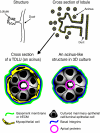Apical polarity in three-dimensional culture systems: where to now?
- PMID: 20092610
- PMCID: PMC2871524
- DOI: 10.1186/jbiol213
Apical polarity in three-dimensional culture systems: where to now?
Abstract
Delineation of the mechanisms that establish and maintain the polarity of epithelial tissues is essential to understanding morphogenesis, tissue specificity and cancer. Three-dimensional culture assays provide a useful platform for dissecting these processes but, as discussed in a recent study in BMC Biology on the culture of mammary gland epithelial cells, multiple parameters that influence the model must be taken into account.
Figures


Similar articles
-
Factors necessary to produce basoapical polarity in human glandular epithelium formed in conventional and high-throughput three-dimensional culture: example of the breast epithelium.BMC Biol. 2009 Nov 16;7:77. doi: 10.1186/1741-7007-7-77. BMC Biol. 2009. PMID: 19917093 Free PMC article.
-
A complex 3D human tissue culture system based on mammary stromal cells and silk scaffolds for modeling breast morphogenesis and function.Biomaterials. 2010 May;31(14):3920-9. doi: 10.1016/j.biomaterials.2010.01.118. Epub 2010 Feb 24. Biomaterials. 2010. PMID: 20185172 Free PMC article.
-
Preadipocytes stimulate ductal morphogenesis and functional differentiation of human mammary epithelial cells on 3D silk scaffolds.Tissue Eng Part A. 2009 Oct;15(10):3087-98. doi: 10.1089/ten.TEA.2008.0670. Tissue Eng Part A. 2009. PMID: 19338449 Free PMC article.
-
Shaping developing tissues by apoptosis.Cell Death Differ. 2004 Aug;11(8):797-9. doi: 10.1038/sj.cdd.4401455. Cell Death Differ. 2004. PMID: 15167902 Review. No abstract available.
-
Cell polarity in motion: redefining mammary tissue organization through EMT and cell polarity transitions.J Mammary Gland Biol Neoplasia. 2010 Jun;15(2):149-68. doi: 10.1007/s10911-010-9180-2. Epub 2010 May 12. J Mammary Gland Biol Neoplasia. 2010. PMID: 20461450 Review.
Cited by
-
SnoN regulates mammary gland alveologenesis and onset of lactation by promoting prolactin/Stat5 signaling.Development. 2012 Sep;139(17):3147-56. doi: 10.1242/dev.079616. Epub 2012 Jul 25. Development. 2012. PMID: 22833129 Free PMC article.
-
Simvastatin treatment varies the radiation response of human breast cells in 2D or 3D culture.Invest New Drugs. 2021 Jun;39(3):658-669. doi: 10.1007/s10637-020-01046-6. Epub 2020 Dec 11. Invest New Drugs. 2021. PMID: 33313978 Free PMC article.
-
Microfluidic model of ductal carcinoma in situ with 3D, organotypic structure.BMC Cancer. 2015 Jan 21;15:12. doi: 10.1186/s12885-015-1007-5. BMC Cancer. 2015. PMID: 25605670 Free PMC article.
-
SATB1 establishes ameloblast cell polarity and regulates directional amelogenin secretion for enamel formation.BMC Biol. 2019 Dec 13;17(1):104. doi: 10.1186/s12915-019-0722-9. BMC Biol. 2019. PMID: 31830989 Free PMC article.
-
Lysophosphatidic acid and sphingosine-1-phosphate promote morphogenesis and block invasion of prostate cancer cells in three-dimensional organotypic models.Oncogene. 2012 Apr 19;31(16):2075-89. doi: 10.1038/onc.2011.396. Epub 2011 Sep 26. Oncogene. 2012. PMID: 21996742 Free PMC article.
References
-
- Bissell MJ. The differentiated state of normal and malignant cells or how to define a "normal" cell in culture. Int Rev Cytol. 1981;70:27–100. full_text. - PubMed
-
- Lelievre S, Bissell MJ. In: Encyclopedia of Molecular Cell Biology and Molecular Medicine. Meyers RA, editor. Weinheim: Wiley-VCH; 2005. Three-dimensional cell culture: The importance of context in regulation of function; pp. 383–420.
-
- Bissell MJ, Kenny PA, Radisky DC. Microenvironmental regulators of tissue structure and function also regulate tumor induction and progression: the role of extracellular matrix and its degrading enzymes. Cold Spring Harb Symp Quant Biol. 2005;70:343–356. doi: 10.1101/sqb.2005.70.013. - DOI - PMC - PubMed
Publication types
MeSH terms
Grants and funding
LinkOut - more resources
Full Text Sources
Other Literature Sources

